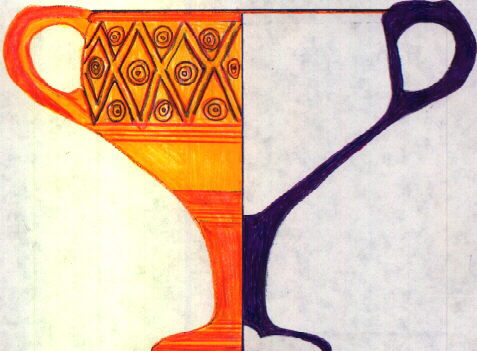

A Mycenaean IIIA Chalice found in Tel Dan, Israel
Neutron Activation Analysis borrows its name from the BIG BANG during which event a mammoth flux of neutrons was created. The same is today done in a nuclear reactor where the sample of pottery or obsidian glass is submitted to a beam of neutrons from a uranium fuel source which converts the elements in matter into a radioactive nuclides.
Neutron Activation Analysis is a collective name for a scientific method to obtain quantification of the chemical elements in the domain of six important fields in Archaeology:
All the above may help the archaeologist/historian in his search for the routes that artifacts traveled (the Trade) and H O W ancient objects--for the major part pottery--was made (the Technology).
Furthermore, a specific interest is aimed at the Precision of Neutron Activation Analysis by the means of intercalibrations between laboratories (as part of my sabbatical spend at the Lawrence Berkeley National Laboratory in 1996 with Dr. Frank Asaro and my ongoing research at the Technical University of Budapest with Dr. Marta Balla
Hence, specific ancient interregional Trade Relations, Trade Routes, perhaps Colonization and Migrations of families, tribes and masses are potentially being traced.
THE PROCEDURE
A pottery sample is taken by grinding off 100 mg of ceramic resulting into a powder. This is then mixed with pure cellulose (50 mg) (as a binder) and pressed into a pellet of uniform size and thickness. The pellets--representing sherds or complete vessels--are wrapped in pure aluminum and set on edge into an aluminum capsule which is sent to a nuclear reactor where it is submitted to a neutron flux. Two or more samples of a Standard of known chemical composition is added to the rest of the pellets.
In other laboratories, weighed pottery powder is placed into tiny polythelene vials. After a preset period of irradiation in a nuclear reactor--the duration of which depends on the size of the neutron flux and whether the elements to be detected have a short or a long halflife--, the capsule (or the vial) is returned, after which each single pellet is measured by the means of a pure Germanium detector for Gamma-Rays. The gamma-rays are converted to electric pulses that are strictly proportional to the energy of the gamma-rays. These pulses are amplified and are send to an "Analogue-to-Digital-Converter" (ADC) which sorts out the pulses from each gamma-ray--according to their energy-- and stores them in the memory of a 'Pulse_Height_Analyzer' set to accumulate data for a preset interval of time. A computer program converts the obtained spectrum of gamma-rays into the abundance of each chemical element present in the fabric of the vessel. Once the chemical abundance is known, one can compare the chemical values with those obtained from clay and wasters from kilns that are site specific. A statistical match means that one has found the place where the pottery was made.
Also the ancient pottery MANUFACTURE TECHNOLOGY may be studied in the light of the chemical compositions obtained by Neutron Activation Analysis and further by Dispersive X-Ray Fluorescence and by thin sections from analyzed pottery (Petrography). One may be able to tell how the potter levigated and/or tempered the raw clay he used to model a vessel and how the pottery was fired providing important information about the technology involved.